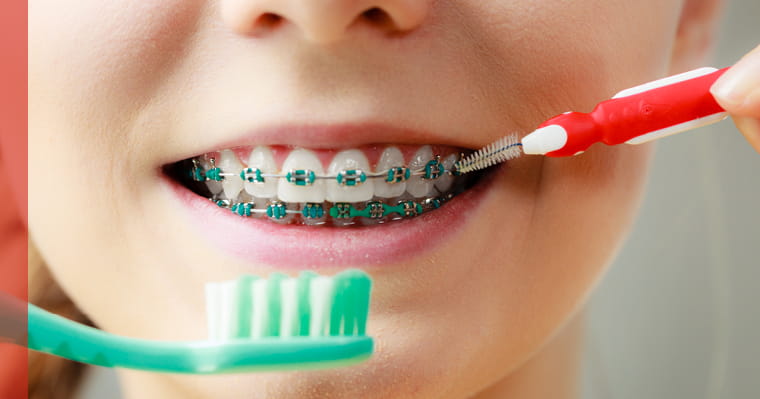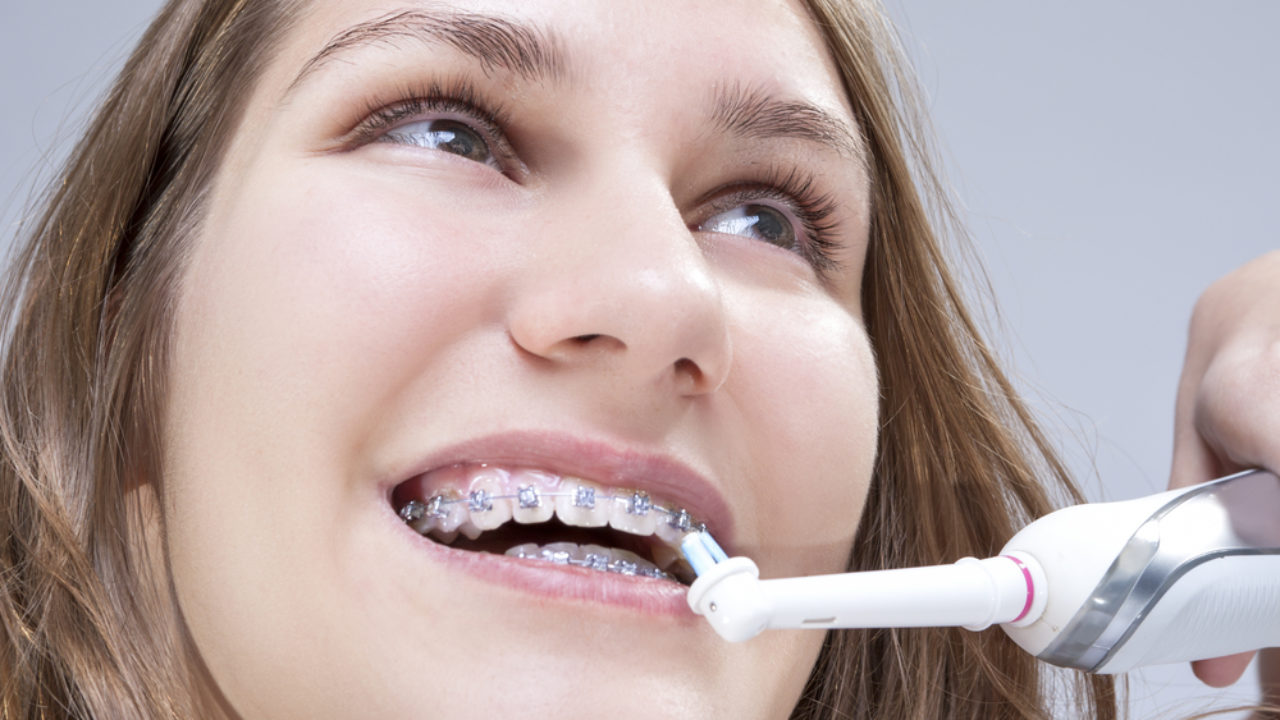BRACE AFTERCARE
HOW TO TAKE CARE OF YOUR BRACES

The Basics: Brushing And Flossing
Careful cleaning is required with braces, because plaque bacteria are easily trapped inside and around them. The following procedure will make daily brushing and flossing both simple and effective.
- Prepare to brush. Take off elastics and any other removable parts of your orthodontic appliance. Rotary or vibratory toothbrushes like Oral B and Sonicare brush without to and fro movement on your braces and teeth, I highly recommend getting one of these.
- Clean your braces. Hold your brush at a 45-degree angle to clean around the wires and pins of your braces. Brush from the top of each wire down to the bottom. Take your time to ensure that all plaque and debris are removed, and that you work all the way around upper and lower teeth.
- Brush your teeth. Clean each tooth individually. First, place your brush at a 45-degree angle the gum line, then apply gentle pressure as you move in a circular motion. Do this for about 10 seconds. Use the same brushing action on all outer and inner tooth surfaces, tilting the brush as needed to better reach the insides of smaller front teeth.
- Floss once a day. Have your dental professional show you the best way to floss, or follow the instructions on the product package. You may also want to use a flossing product designed for braces and orthodontic work, like a floss threader.
- Rinse and check your teeth. Rinse thoroughly with water or mouth rinse, and examine your teeth and braces in the mirror.
- Professional Care: Dentist And Orthodontist Visits
BRACE AFTERCARE IS AS IMPORTANT TO YOUR TREATMENT AS HAVING THE ACTUAL BRACE FITTED!
Some people experience very few problems having their braces fitted whereas others find the adjustment more difficult – Here are some handy brace aftercare tips to help see you through and try to make managing them a breeze! If you need to see us or to ask a questions, please get in touch right away. Making sure you’re comfortable is our priority.
AS SOON AS YOUR BRACES ARE FITTED
It is totally normal for your brace to feel a bit scratchy and big when you first have your fixed braces fitted – your soft tissues will adapt over 2-3 days and the brace will feel like it’s always been there.
ORTHODONTIC WAX
Sometime the brackets can feel rough on your cheeks and lips – use the wax we have given you to alleviate the rubbing. Take a large piece, roll it into a ball and place it over the bracket – It’s important to stick the wax to a dry bracket as your saliva can stop it from sticking – Tip! Pull your lip out of the way and breathe in through your teeth to make it dry or use a hairdryer on the cool setting! Don’t be tempted to use a towel to dry the brace – the loops can get caught on the bracket and pull it off.
INITIAL BRACE MOVEMENT
Your brace brackets (the wire between each of the metal squares) put a constant, gentle force onto your teeth which will mean that in the first few hours after the brace has been fitted your teeth will feel a bit bruised or achey – again this is to be expected and totally normal, but will wear off.
If it is anymore than bruised & sore feeling, you can take ibuprofen or paracetamol, whichever you would normally take for a headache. Be sure to read and follow the dose instructions on the packet.
FOODS TO AVOID
For the first few days you will need to steer clear of hard, chewy & tough foods like French baguettes and try to have a softer diet – like mashed potato, pasta or white fish.
It is also important to limit the amount of sugary foods in your diet to keep your brace immaculately clean. Throughout the duration of your treatment you need to avoid biting into hard foods like apples or carrots. The direction of force applied when eating these types of food is the same that we use to debond your brace, so you could end up sheering the brackets off of your teeth. (This won’t be painful, but you will need to come back in, and of course, the brace won’t be working if its not bonded to your tooth).

CLEANING YOUR BRACE
Once your brace is fitted the brace aftercare is its down to you. Happy, healthy, clean teeth move faster than teeth covered in plaque and if any plaque goes hard it can stop the teeth from moving along the brace altogether!
When cleaning your teeth think of your teeth in 3 sections – 1. On top of your brace. 2. Your brace and 3. Below your brace.
The aim is to reach as much of your tooth surface with the toothbrush bristles as possible.
You should also use a single tufted toothbrush, to get to the tooth surface behind the brace wire, clean the tooth surface and the side of each bracket.
Tip! – You’ll need to allow about 5 minutes for teeth cleaning and most of our patients take a travel toothbrush in their bag and decant some mouthwash into a travel bottle so they can get food out of their brace at lunchtime.

DECALCIFICATION
If you don’t keep your teeth and your brace clean and reduce your sugar intake you are likely to get decalcification – which is irreversible. Decalcification is the beginnings of decay and starts as white lesions that progress to brown and eventually, becomes decay. The worst thing about it is the squares it leaves on your teeth. You don’t want perfectly straight teeth with yellow squares. If you are thorough and consistent with your cleaning regime and brace aftercare this won’t happen!

OTHER THINGS TO CONSIDER
Breakages can delay your treatment time – so avoid biting on anything with your front teeth. Use your back teeth to chew tough food like baguettes, pizza crust, toffees, carrots and apples. While we will always see you for breakages they can sometimes mean we have to go back a few steps in your treatment so try and avoid them. If you do have a breakage make sure you come in and see us ASAP!
If you play contact sports while in braces, please make sure you wear a mouth guard to protect your teeth, gums and braces.
Regular appointments and cleaning is a vital part of brace aftercare. Missing appointments can also delay your treatment time, so try and be organised – book a few in advance so that we see you often.
Caring for Teeth After Getting Braces Off
Once the braces are removed and the great new smile is revealed, many assume the care stops there. This assumption is inaccurate. A beautiful, new smile is the long-awaited reward that can be kept pristine and healthy through various ways, post-braces.
- One of the first ways of caring for teeth after braces are removed is to keep up on teeth cleanings and check-ups. Parents should continue taking their children to the primary care dentist for routine cleanings twice per year. This will keep oral health in good condition.
- Teeth will not stay pearly white for long if consistent brushing and flossing habits are not developed. Once braces come off, these two actions become significantly easier. Parents should continue to encourage their child to brush and floss at least twice daily.
How to Keep Teeth Beautiful with Retainers
Undoubtedly, one of the most important steps in keeping post-braces teeth straight and beautiful are retainers. Retainers come in several different options and are made from an impression of the child’s teeth on the day they finish treatment. Whether it is a removable or fixed type of retainer, your child’s new smile can be preserved and kept in the same position as it was the moment their braces were removed.
Although retainers may feel unusual at first, patients adapt quickly and will be totally comfortable after the first week or so. Retainers that can be taken in and out should be worn consistently at night (while sleeping) for the teeth to remain stable long-term.
Even missing one night of wearing retainers can allow teeth to move. Patients should be diligent in wearing their retainer nightly. In addition, if a retainer is broken, lost, damaged, or ill-fitting, visit the orthodontist as soon as possible for a repair or replacement. Orthodontic treatment was an investment in your child’s oral health and future, and we want to make sure it stays beautiful for a lifetime.
Fixed (permanent) retainers are another retainer option and are highly recommended in most cases. These are the best retainers for holding teeth straight and require minimal cooperation.

